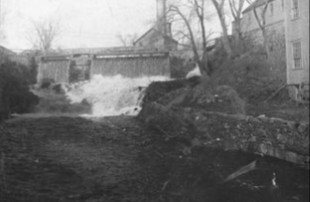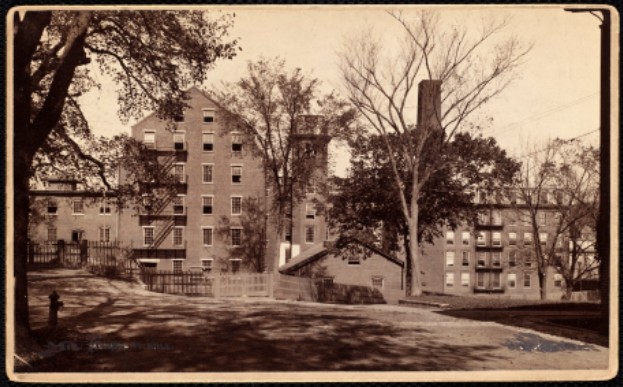Methuen Co. Mills 1, 2, 3 and Methuen Falls
Introduction
Text-to-speech Audio
Once a prominent feature of Methuen, this old mill site has since been converted into apartment buildings.
Images
The Methuen Falls

The Methuen Mills 1, 2, and 3

Backstory and Context
Text-to-speech Audio
According to an account published in the Transcript in October 1905 the first known reference to use of the falls was found in a deed belonging to David Nevins. The deed, from the widow of John Morrill, dated December 1709, conveyed to Robert Swan, for the sum of thirty pounds, one-forth of a saw mill and land "on Spicket river falls, the mill that was built by and belonged to and amongst Robert Swan, John Morrill and Elisha Davis." Afterwards, a grist mill was built on each side of the river, and as there was not enough business to keep them both busy, they agreed to run on alternate weeks. This arrangement kept up until the first cotton mill was built by Stephen Minot in 1814. It burned in 1818, and in 1821 the land and water privilege were purchased by the Methuen Company, which built a new mill in 1826-1827 (47 Osgood St). The Methuen Company was acquired by David Nevins in 1864. The company quadrupled in size between 1870 and 1881 and it was during this time that the new dam was built. A lithograph "View of the Falls and Mills on the Spigot River, Methuen, Mass." shows the Methuen Company buildings c1836-37.
The Methuen Company was acquired by Boston investor David Nevins in 1864. Under Nevins, who also owned the Pemberton Mill in Lawrence and mills in Salem and Webster, the Methuen Company quadrupled in size between 1870 and 1881, producing cotton duck, cotton flannel, ticking, awnings, and jute bags. Increases in production required additional water power and in 1880, the old wooden dam was replaced by a new dam built of granite from Nevins' Salem, N.H. quarry (Lowell St). The Methuen Company remained in business into the twentieth century and was for a time part of the Arlington Mills (NR). By the 1930s, the buildings were rented for other industrial uses. The Inventory of Historic Engineering and Industrial Sites states that the Methuen Mills complex is one of the best preserved textile mill sites in the lower Merrimack Valley.
An account of construction of the dam in the Transcript in October 1898 stated that the center portion of the present dam was built in 1880 by David Crockett. It took the place of the old dam, constructed principally of wood, which was about 12 feet up stream. (The front of the old dam was wood, with stone in the rear to prevent the wood from being forced out.) The stone for the new dam came from a Salem, N.H. quarry owned by David Nevins. Holes half the size of a cannonball were carved from the tops and bottoms of each stone so that a cannonball could be fitted in between each layer for reinforcement. The dam is said to be about 140 feet long with the highest fall of water being about 23 feet. On the right end, the fall is not as high. This section was constructed about 10 years before by Mr. Simmons, a Lawrence contractor. A contemporary photograph shows the dam with a wooden walk way across it, which was completed in November 1880. - Description courtesy of Dan Gagnon, historian.
